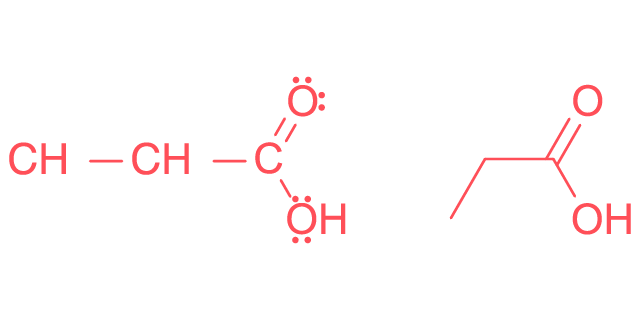Propionic Acid

Linear Formula
C3H6O2
Synonyms
propanoic acid, acid propanoic, carboxyethane, ethanecarboxylic acid, ethylformic acid, metacetonic acid, methylacetic acid, propionate
Share this metabolite
Propionic acid, or propanoic acid, is an organic acid that appears as a colorless oily liquid and gives off a rancid odor. While the chemical is miscible with water, adding salt to the solution removes propionic acid from the solvent. These physical properties make propionic acid an organic acid with intermediate properties between the smaller organic acids and larger fatty acids.
Propionic acid is also a short chain fatty acid (SCFA). Compounds classified as SCFAs, including acetic acid and butyric acid, are carboxylic acids of at least two carbons and up to six carbons long. Although exposure to propionic acid above exposure limits causes harm, emerging research also shows its importance in human health.
Propionic acid and chemical hazards
The European Chemicals Agency1 and the American Chemical Society2 have classified propionic acid and other SCFAs as hazardous substances. Propionic acid is corrosive, causing skin burns upon skin contact. Contact with the eyes causes blurred vision and requires immediate medical attention. Interestingly, propionic acid is only slightly toxic to animals.
Propionic acid and agricultural chemicals
Despite being a hazardous chemical, farmers use propionic acid as an additive and preservative in animal feed3. Propionic acid is also a potent food preservative, especially when used in bread and other baked goods. Farmers also add propionic acid to animal drinking water because of the chemical’s antioxidant properties4. Its industrial benefits have encouraged efforts to biosynthesize propionic acid from Propionibacterium acidipropionici. Propionic acid fermentation occurs among members of the Propionibacterium genus5. Microbes in this genus decarboxylate succinic acid to produce propionic acid, releasing carbon dioxide as a byproduct6.
Propionic acid and the digestive system
Bacteria in the gastrointestinal tract also produce propionic acid and other SCFAs as metabolic byproducts. There, bacteria undergo a fermentation process to produce SCFAs from indigestible fibers. SCFAs like propionic acid may improve blood pressure control and help regulate the immune system after being readily incorporated through the bloodstream7.
Despite these benefits, propionic acidemia can arise from propionic acid accumulation. Propionic acidemia is a rare condition where individuals cannot break down certain amino acids and fatty acids. Because propionic acidemia can be life-threatening, patients must only eat foods low in protein to reduce the risk of acute metabolic episodes. Propionic acid produced in the gut is also associated with autism spectrum disorders. According to behavioral brain research, excess propionic acid production may lead to large doses that drive neuroinflammation through the gut-brain axis8,9.
Propionic acid and the skin
Although propionic acid can cause skin burns, the beauty industry regularly supplements cosmetic products with propionic acid. Propionic acid bacteria, namely Propionibacterium acidipropionici, undergo a fermentation process that facilitates propionic acid production. While propionic acid helps maintain skin pH and has antimicrobial properties, excess propionic acid fermentation may contribute to skin cell cytotoxicity10.
Propionic acid in research
As of July 2023, there are over 4,000 citations for “propionic acid” in research publications (*excluding books and documents) on PubMed. The extensive number of publications linking the gut microbiome, propionic acid, and a variety of metabolic conditions suggests that any researcher interested in the link between the microbiome and metabolic function may consider including quantitative analyses of propionic acid in their study. Similarly, due to propionic acid’s role in maintaining healthy skin, including propionic acid quantification in any skin disease research studies is likely to be a useful addition.
References
- European Chemicals Agency. Substance Infocard – Propionic acid. European Chemicals Agency. Accessed July 12, 2023. https://echa.europa.eu/substance-information/-/substanceinfo/100.001.070
- CDC – NIOSH Pocket Guide to Chemical Hazards – Propionic acid. Accessed July 12, 2023. https://www.cdc.gov/niosh/npg/npgd0529.html
- Additives EP on, Feed (FEEDAP) P or S used in A. Scientific Opinion on the safety and efficacy of propionic acid, sodium propionate, calcium propionate and ammonium propionate for all animal species. EFSA Journal. 2011;9(12):2446.
- Gad SC. Propionic Acid. In: Wexler P, ed. Encyclopedia of Toxicology (Third Edition). Academic Press; 2014:1105-1107. doi:10.1016/B978-0-12-386454-3.00914-3
- Piwowarek K, Lipińska E, Hać-Szymańczuk E, Kieliszek M, Ścibisz I. Propionibacterium spp.—source of propionic acid, vitamin B12, and other metabolites important for the industry. Appl Microbiol Biotechnol. 2018;102(2):515-538. doi:10.1007/s00253-017-8616-7
- Whiteley HR. The Mechanism of Propionic Acid Formation by Succinate Decarboxylation: I. The Activation of Succinate. Proceedings of the National Academy of Sciences. 1953;39(8):772-779.
- Tan J, McKenzie C, Potamitis M, Thorburn AN, Mackay CR, Macia L. The role of short-chain fatty acids in health and disease. Adv Immunol. 2014;121:91-119. doi:10.1016/B978-0-12-800100-4.00003-9
- El-Ansary AK, Bacha AB, Kotb M. Etiology of autistic features: the persisting neurotoxic effects of propionic acid. Journal of Neuroinflammation. 2012;9(1):74. doi:10.1186/1742-2094-9-74
- Choi J, Lee S, Won J, et al. Pathophysiological and neurobehavioral characteristics of a propionic acid-mediated autism-like rat model. PLOS ONE. 2018;13(2):e0192925. doi:10.1371/journal.pone.0192925
- Tax G, Urbán E, Palotás Z, et al. Propionic Acid Produced by Propionibacterium acnes Strains Contributes to Their Pathogenicity. Acta Dermato-Venereologica. 2016;96(1):43-49. doi:10.2340/00015555-2154

